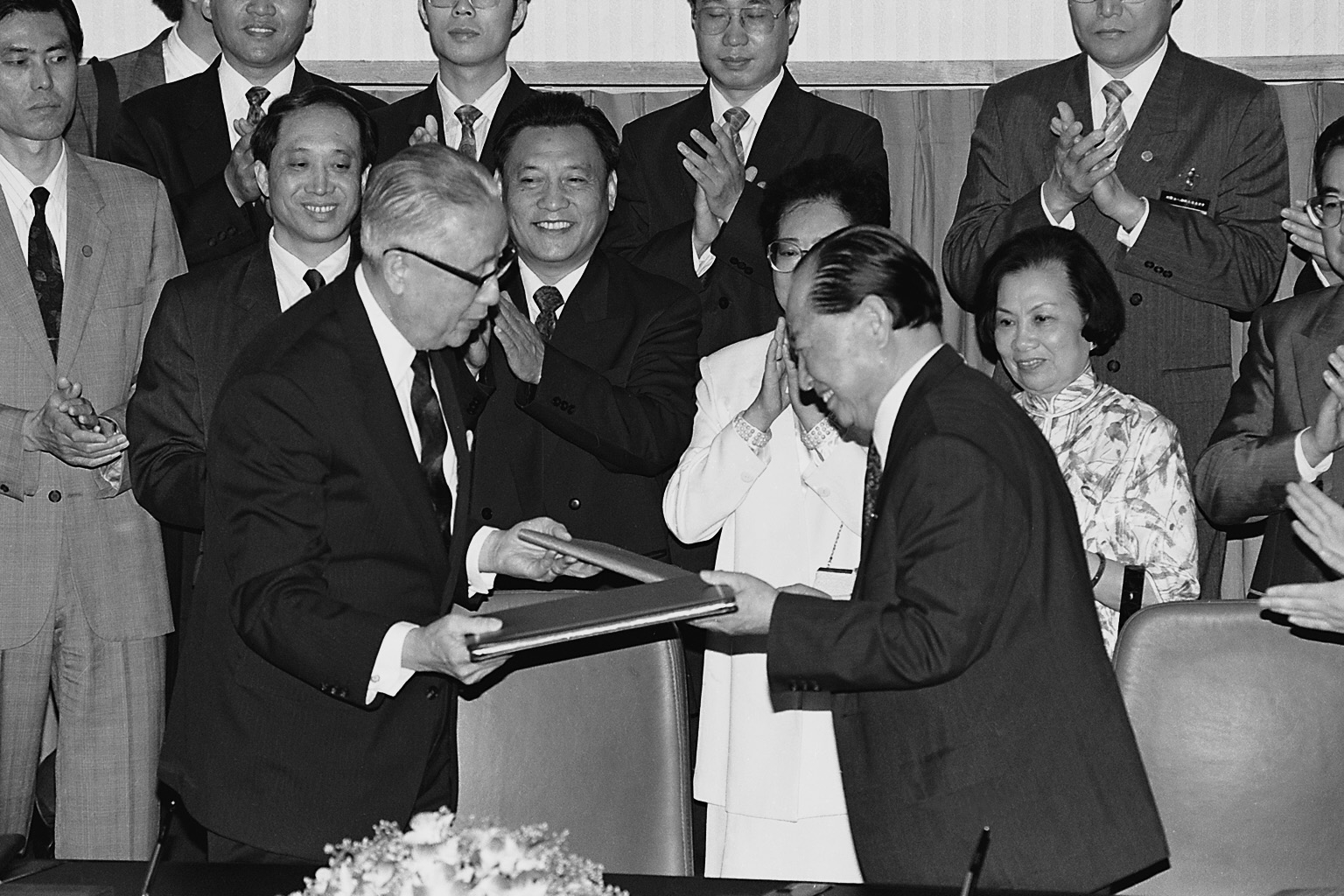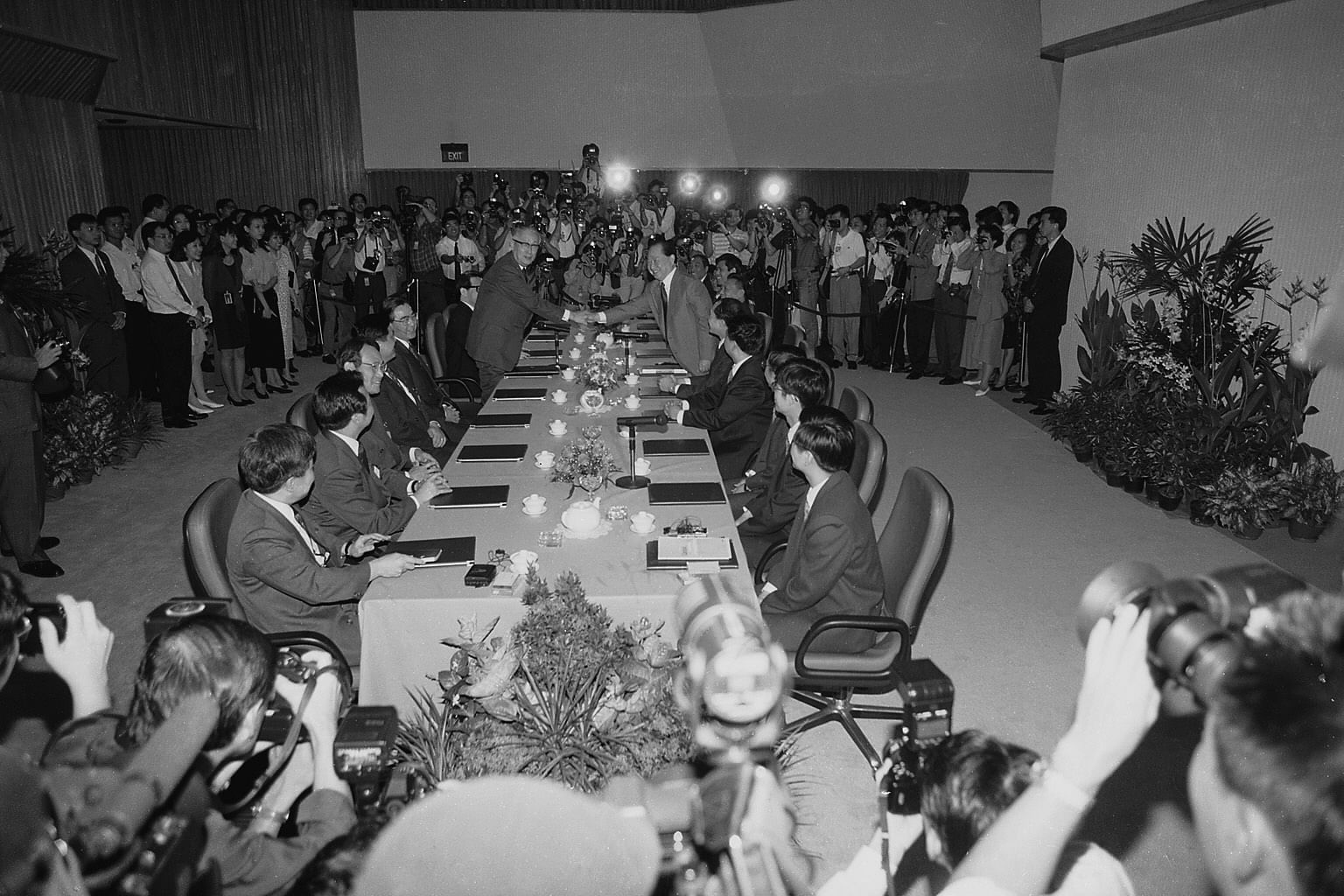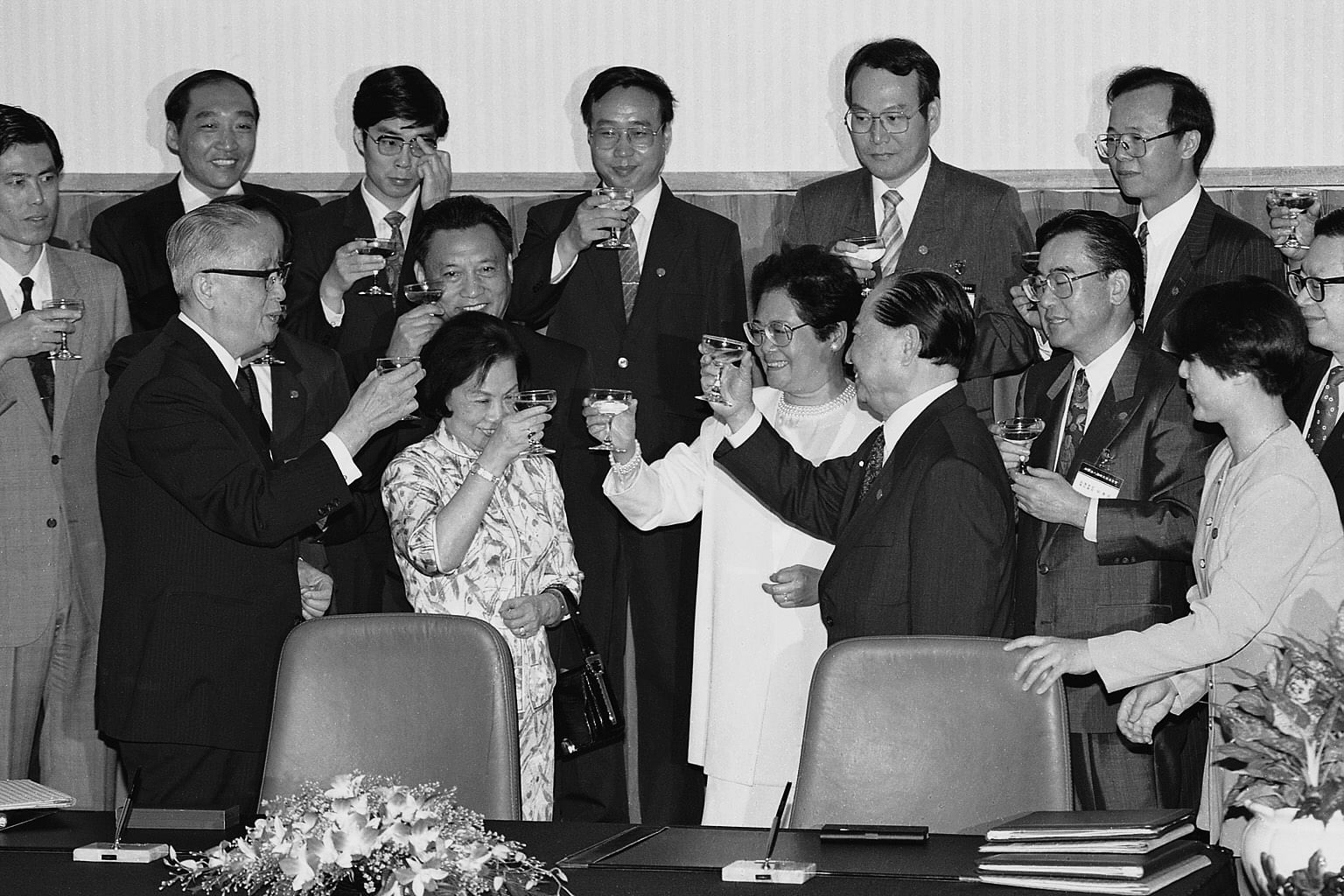From The Straits Times Archives: 1993 landmark China-Taiwan bilateral talks in Singapore
Sign up now: Get insights on Asia's fast-moving developments

Taiwan's Koo Chen-fu (left) and China's Wang Daohan exchanging documents to sign at the conclusion of talks between the two sides in Singapore on April 29, 1993.
PHOTO: ST FILE
Follow topic:
SINGAPORE - The upcoming historic meeting between China President Xi Jinping and Taiwan President Ma Ying-jeou in Singapore on Saturday (Nov 7) is the first time top leaders from both sides come face-to-face following the Chinese Civil War in 1949.
But it is not the first time that the Republic has hosted a landmark meeting that saw the two political rivals discuss bilateral ties. In 1993, several agreements were reached by the heads of two-semi-government bodies to further cross-strait economic, cultural and technical exchanges.
We trawl through The Straits Times archives for a better look at what transpired in the so-called "Wang-Koo" meetings more than two decades ago.
1. Who were the two officials involved?

Preliminary discussions to pave the way for the meeting started on April 21, 1993, with senior officials subsequently confirming that talks will be held between Taiwan's Straits Exchange Foundation (SEF) chief, Mr Koo Chen-fu, and chairman for China's Association for Relations Across the Taiwan Straits (Arats), Mr Wang Daohan, starting April 27.
Initial reports had touted the talks as "technical and functional" in nature, and would deal mainly with civilian, administrative and economic matters.
For detailed profiles on Mr Wang and Mr Koo by ST China Desk's Leong Weng Kam, click on the links in their names.
2. Why was Singapore chosen as the venue?

While it was clarified that the Republic's position was that of a neutral one, the SEF's secretary-general Cheyne Chiu said the choice was a unanimous one because of Singapore's "good leadership and reputation" of its government.
He added that the preference was to hold the first high-level meeting in a neutral third country as conducting it in either Taiwan or China would make it "awkward" for the two sides.
The talks were eventually held from April 27-29 in the conference room on the 26th level of the NOL Building along Alexandra Road.
3. Were there any concerns from the two sides over the talks?
The Singapore talks alarmed Taiwan's main opposition, the Democratic Progressive Party (DPP), which had wanted the island to declare independence and abandon the goal of reunification.
They were afraid that Mr Koo might "betray" Taiwan, which prompted then-President Lee Teng-hui to assure the Taiwan people that the government would not move towards reunification without consulting them.
Both Beijing and Taipei's Nationalist (Kuomintang) government had said they were committed to the eventual reunification of Taiwan and China.
4. Prepatory discussions on April 24 set the tone for the meeting
Mr Tang Shubei, vice-chairman of Arats, met with Mr Chiu to settle on a time-frame for future contacts between their officials, with director-level meetings to be held once in three months and secretary-general level discussions staged half-yearly.
Such meetings would be held either in China or Taiwan. They also expressed hope that future meetings between Mr Wang and Mr Koo can take place at least once a year.
There were also doubts over Mr Koo's last-minute non-participation as DPP members had branded his family as traitors during the Japanese Occupation years, with Mr Koo threatening to quit his post.
5. No chance for reunification to be on the agenda
Prior to the meeting, Mr Koo had indicated that there was no chance of the topic of political reunification being added to the agenda.
This was in contrast to comments by Mr Wang on his arrival in Singapore on April 25. He had hinted that the talks could go beyond the non-political agenda and said both sides should take a more forward-looking attitude to the future.
"We stand for peaceful reunification. As both sides share the wish to develop better mutual relations and achieve peaceful reunification, there is nothing we cannot sit down and talk about," he added.
6. "Tense" atmosphere prior to first day of talks

The opening day saw both sides agreeing to formalise official contacts between Arats and SEF, but it was underscored by some tension when a delegation of 12 legislators from Taiwan's DPP showed up to challenge the SEF's right to represent the Taiwanese.
More than 200 journalists from China, Taiwan, Hong Kong and other Asian countries came to cover the event.
7. Talks hit a snag, extended for a third day
The two-day meeting stretched into a third day when both sides could not resolve issues on economic cooperation on April 28.
China had wanted direct trade, postal and transportation links with Taiwan to further strengthen their economic ties, as well as the restrictions on Taiwan investments on the mainland as well as Chinese imports to Taiwan to be eased.
Taiwan, meanwhile, pushed for a pact to provide legal protection for Taiwan investments and businesses in China.
8. Four historic pacts signed, economic issues unresolved

Mr Wang and Mr Koo put their signatures on four documents during a 20-minute ceremony televised live to Taiwan on the morning of April 29. The first was a joint statement in which they spelt out their commitment to have greater economic, cultural, scientific, youth and media exchanges.
The other three agreements were:
- The agenda for discussions in 1993 will cover repatriation of illegal immigrants to each side, joint efforts to crack down on marine smuggling and robbery, settlement of fishing disputes, protection of intellectual property, and contact and assistance between judicial and legal entities;
- To look into strengthening of exploration and exchanges on energy and resources;
- That the issues of investment rights in China and related problems of Taiwanese investors as well as exchanges between industry and business will be the focus of discussions at a place and time to be decided.
However, both sides agreed to iron out economic issues at a later date after they remained unresolved.

